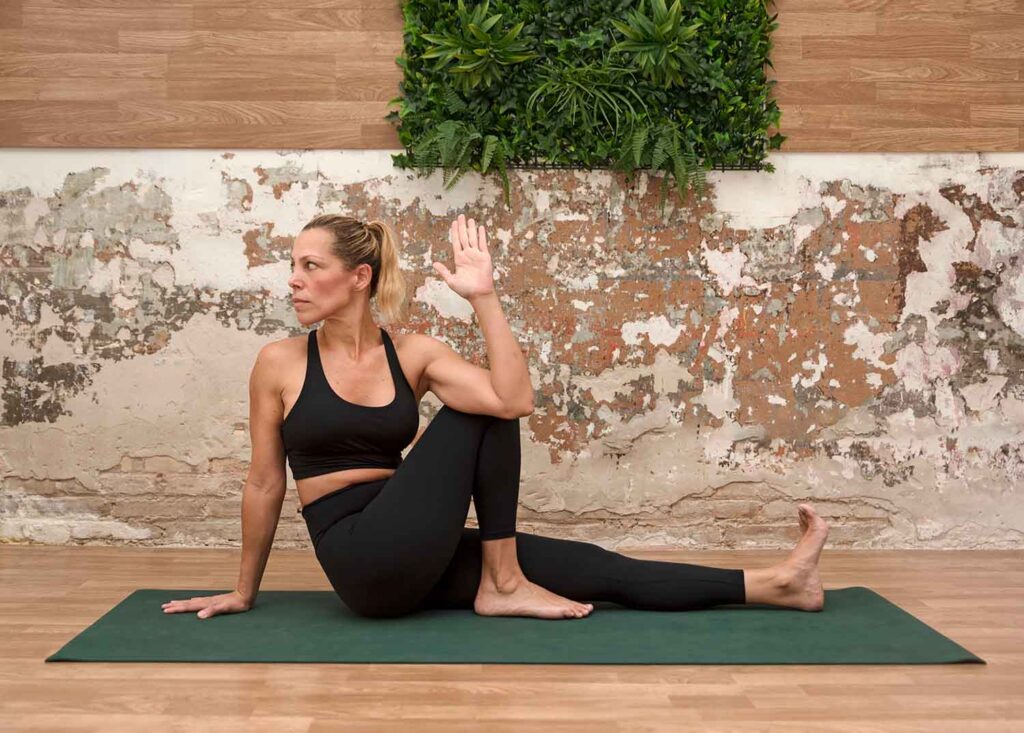Sage Twist pose in yoga, or Marichyasana in Sanskrit, is a seated twisting yoga posture that improves spinal mobility and digestion while calming the mind. Named after the sage Marichi, this pose offers a blend of strength and flexibility, targeting the spine, hips, and shoulders.
Other Names for Sage Twist
- Marichyasana A (basic variation)
- Marichi’s Pose
- Seated Twist
How to Do Sage Twist in Yoga
Follow these steps to perform Sage Twist effectively:
- Begin in Staff Pose (Dandasana): Sit with both legs extended in front of you. Keep your spine straight, and place your hands beside your hips, grounding through your sitting bones.
- Bend Your Right Knee: Bring your right foot close to your pelvis, ensuring your left leg remains extended and active, with the foot flexed.
- Reach Your Left Arm Around Your Right Knee: On an inhale, lift your left arm up. As you exhale, twist your torso to the right, wrapping your left arm around your bent knee. Place your right hand behind you on the floor for support.
- Deepen the Twist: With each inhale, lengthen your spine, and with each exhale, twist deeper. Gaze over your right shoulder, keeping the twist gentle and stable.
- Hold the Pose: Stay in the twist for 30 seconds to a minute, breathing deeply. Slowly unwind and repeat on the opposite side.
Key Alignment Points:
- Keep your chest open, not collapsing.
- Ground both sitting bones evenly.
- Engage your core to support the twist.
Variations of Sage Twist in Yoga
- Marichyasana A: The basic variation described above.
- Marichyasana B: Involves binding the hands behind the back to intensify the twist and shoulder stretch.
- Revolved Sage Twist: Deepen the pose by twisting the torso more, aiming for a deeper spinal rotation.
Modifications for Sage Twist in Yoga
- Use a Block or Strap: If your hands don’t reach the floor or each other for the bind, use a block behind you or a strap to assist in the bind.
- Support Under Hips: Place a folded blanket under your hips if you have tight hips or hamstrings, allowing the spine to stay straight.
Contraindications for Sage Twist in Yoga
Approach Sage Twist with care if you experience the following:
- Spinal Injuries: Avoid deep twists if you have existing spinal issues or discomfort.
- Pregnancy: Twists can compress the abdomen. Opt for more open twists or consult with a yoga instructor.
- Knee Injuries: Avoid placing too much pressure on the bent knee. Modify as needed to avoid strain.
Tips to Improve Sage Twist in Your Practice
- Lengthen the Spine First: Before twisting, always lengthen your spine by sitting tall. Twisting from a rounded back can strain the spine.
- Use Props: A block under your hand can help support the twist, especially if you’re not able to reach the floor.
- Engage the Core: A strong core will support your lower back and enhance the twist. Always activate your abdominal muscles as you rotate your torso.
- Don’t Force the Twist: Twisting too deeply can strain the back. Focus on gradually increasing your range of motion as your body allows.
- Breathe Into the Twist: Use your breath to guide the pose. Inhale to lengthen the spine, and exhale to twist deeper, helping you open up without forcing the posture.
What Muscles Does Sage Twist Work?
- Spinal Muscles: Strengthens and stretches the erector spinae muscles that support the spine.
- Abdominals: Engages the obliques, helping build core stability.
- Shoulders: The twist opens the chest and stretches the shoulder muscles.
- Hips and Hamstrings: Stretches the extended leg’s hamstrings and the bent leg’s hip flexors.

Mental and Emotional Benefits of Sage Twist in Yoga
- Mental Clarity: The act of twisting helps detoxify the body, which can also clear the mind and reduce stress.
- Emotional Release: Twists help release tension stored in the body, particularly in the back and shoulders, promoting emotional relaxation.
- Improved Focus: By engaging the breath and focusing on alignment, Sage Twist enhances concentration and mindfulness.
Is Sage Twist Suitable for Beginners?
Yes, Sage Twist is accessible for beginners with some modifications:
- Use Props: Beginners can place a block under the sitting bones to maintain a straight spine or a strap to assist in the twist.
- Focus on Gentle Twists: Instead of aiming for a deep twist, new practitioners should focus on maintaining proper alignment and gentle rotation of the spine.
Is Sage Twist Suitable for Advanced Practitioners?
For advanced practitioners, Sage Twist offers opportunities to deepen:
- Explore Binds: Advanced yogis can work toward binding the hands behind the back, deepening both the twist and the stretch in the shoulders.
- Increase Twist Depth: With improved flexibility, advanced students can work on increasing the rotation through the torso while maintaining spinal alignment.
- Extended Hold Times: Holding the pose longer helps strengthen endurance and mental focus.
How Does Sage Twist Contribute to a Yoga Sequence or Flow
Sage Twist is typically included in sequences for several reasons:
- Neutralizes the Spine: After deep backbends or forward bends, twists like Sage Twist help neutralize and reset the spine, reducing tension.
- Improves Digestion: Twists stimulate the digestive organs, making them a great inclusion toward the end of a yoga practice, especially in flows designed to boost digestion and energy flow.
- Prepares for Deeper Twists: It can serve as an entry-level pose to prepare the spine and hips for more challenging twisting postures like Revolved Triangle or Bound Half Lotus Twist.
- Creates Balance: Twisting poses in sequences balance other poses that stretch or strengthen the spine. They also promote mobility and core strength for transitions between standing and seated postures.
How Can I Deepen My Practice in Sage Twist?
- Work on Flexibility First: Deepen the twist by gradually increasing flexibility in your spine, hips, and hamstrings. Practicing poses like Seated Forward Fold or Half Lord of the Fishes can help.
- Add a Bind: For a more intense challenge, try binding the arms around the bent knee and behind the back, which will open the shoulders and deepen the twist.
- Focus on Core Engagement: As you twist, engage your core muscles to protect your lower back and maintain stability.
- Practice with Props: Use a yoga block behind your back to create more leverage in the twist as you build flexibility.
Common Mistakes in Teaching Sage Twist
- Rounding the Spine: Twisting from a rounded spine can cause strain. Always instruct students to lengthen their spine before rotating.
- Forcing the Twist: Many practitioners try to force a deeper twist than their body allows. Encourage students to twist only as far as feels comfortable and to use breath to deepen gradually.
- Neglecting the Hips: Sitting bones should stay evenly grounded. Lifting one hip or leg off the floor can misalign the spine, so always ensure even weight distribution.
- Lack of Breath Focus: Twists are most effective when combined with deep breathing. Instruct students to focus on lengthening the spine on inhales and deepening the twist on exhales for a more mindful approach.
By addressing these key areas in Sage Twist, both beginners and advanced practitioners can deepen their practice, enjoy the physical benefits, and experience a greater sense of mental clarity and emotional release.
What are the benefits of Sage Marichi pose?
The benefits of Sage Marichi pose include improved spinal flexibility, enhanced digestion, and stimulation of internal organs. Also known as Marichyasana or Sage Twist, this seated yoga posture helps detoxify the body, strengthen the back muscles, and calm the mind through focused, mindful breathing.
Can Marichyasana improve flexibility?
Yes, Marichyasana can improve flexibility by lengthening the spine, hamstrings, and hips. Commonly known as the Sage Twist, this seated yoga posture enhances range of motion through deep spinal rotation and forward folding, making it beneficial for practitioners of Hatha Yoga and other flexibility-focused disciplines.
What do twists mean in yoga spiritually?
Twists in yoga spiritually symbolize release, transformation, and inner cleansing. They are believed to help detoxify the energetic body and stimulate the flow of prana, or life force. Poses like the Sage Twist (Marichyasana) support self-reflection, balancing the chakras and promoting emotional clarity in practices rooted in Hatha Yoga and Kundalini Yoga.

